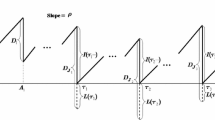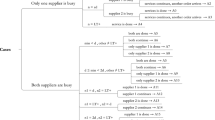Abstract
We consider a (Q, r) perishable inventory system with state-dependent compound Poisson demands with a random batch size, general lead times, exponential shelf times, and lost sales. We assume \(r<Q\) and analyze the system using an embedded Markov process at the replenishment points. Using the queueing and Markov chain decomposition approach, we characterize the distribution of the residual lead time and derive the stationary distribution of the inventory level. We construct closed-form expressions for the expected total long-run average cost function. The closed form allows us to efficiently obtain, numerically, the optimal Q and r parameters. Numerical study provides several guidelines for the optimal control. For example, we show that approximating the lead time distribution by an exponential one only works when the optimal reorder point of the approximation is very small; in other cases the usage of the exact distribution can lead to substantial cost savings (up to 14%). We further provide intuition insight on the optimal controls and how they depend on different factors, e.g., the lead time variability, and the demand features (arrival rate, size and variability).






Similar content being viewed by others
References
Abouee-Mehrizi H, Baron O, Berman O, Chen D (2018) Managing perishable inventory systems with multiple demand classes. Prod Oper Manag 28(9):2305–2322
Asmussen S (2003) Applied probability and queues, 2nd edn. Springer, New York
Axsäter S (2006) Inventory control, 2nd edn. Springer, New York
Baron O, Berman O, Perry D (2011) Shelf-space management when demand depends on the inventory level. Prod Oper Manag 20(5):714–726
Barron Y (2016) Clearing control policies for MAP inventory process with lost sales. Eur J Oper Res 251(2):495–508
Barron Y (2018) An order-revenue inventory model with returns and sudden obsolescence. Oper Res Lett 46(1):88–92
Barron Y (2019) A state-dependent perishability \((s, S)\) inventory model with random batch demands. Ann Oper Res 280(1–2):65–98
Baron O, Economou A, Manou A (2016) The State-dependent M/G/1 queue with orbit: analysis and strategic customer behavior
Barron Y, Baron O (2020) QMCD approach for perishability models: the \((S, s)\) control policy with lead time. IISE Trans 52:133–150
Berk E, Gürler Ü (2008) Analysis of the \((Q, r)\) inventory model for perishables with positive lead times and lost sales. Oper Res 56:1238–1246
Bijvank M (2009) Service inventory management: solution techniques for inventory systems without backorders. PhD thesis, Vrije Universiteit Amsterdam, The Netherlands
Bijvank M, Vis IF (2012) Lost-sales inventory systems with a service level criterion. Eur J Oper Res 220(3):610–618
Boxma O, Kella O, Perry D (2001) An intermittent fluid system with exponential on-times and semi-Markov input rates. Probab Eng Inf Sci 15(2):189–198
Buzacott JA, Shanthikumar JG (1985) Approximate queueing models of dynamic job shops. Manag Sci 31:870–887
Buzby JC, Farah-Wells H, Hyman J (2014) The estimated amount, value, and calories of postharvest food losses at the retail and consumer levels in the United States. USDA Economic Research Service, Washington
David I, Mehrez A (1995) An inventory model with exogenous failures. Oper Res 43(5):902–903
Economou A, Manoum A (2015) A probabilistic approach for the analysis of the \(M_{{\rm n}}/G/1\) queue. Ann Oper Res. https://doi.org/10.1007/s10479-015-1943-0
Fattahi P, Hajipour V, Nobari A (2015) A bi-objective continuous review inventory control model: pareto-based meta-heuristic algorithms. Appl Soft Comput 32:211–223
Feng L, Chan YL, Cárdenas-Barrón LE (2017) Pricing and lot-sizing policies for perishable goods when the demand depends on selling price, displayed stocks, and expiration date. Int J Prod Econ 185:11–20
Galliher HP, Morse PM, Simond M (1959) Dynamics of two classes of continuous-review inventory systems. Oper Res 7(3):362–384
Goyal SK, Giri BC (2001) Recent trends in modeling of deteriorating inventory. Eur J Oper Res 134(1):1–16
Grob C, Bley A (2018) Comparison of wait time approximations in distribution networks using \((R,Q)\)-order policies. arXiv preprint arXiv:1801.09617
Gürler Ü, Özkaya BY (2008) Analysis of the \((s, S)\) policy for perishables with a random shelf life. IIE Trans 40(8):759–781
Isotupa KS (2006) An \((s, Q)\) Markovian inventory system with lost sales and two demand classes. Math Comput Model 43(7):687–694
Isotupa KS, Samanta SK (2013) A continuous review \((s, Q)\) inventory system with priority customers and arbitrarily distributed lead times. Math Comput Model 57(5–6):1259–1269
Karaesmen IZ, Scheller-Wolf A, Deniz B (2011) Managing perishable and aging inventories: review and future research directions. In: Kempf KG, Keskinocak P, Uzsoy R (eds) Planning production and inventories in the extended enterprise. Springer, Boston, pp 393–436
Karaman AS (2017) Approximate evaluation of continuous review \((R, Q)\) policies in two-echelon inventory systems with stochastic transportation times. Kybernetika 53(3):461–479
Kouki C, Jemaï Z, Minner S (2015) A lost sales \((r, Q)\) inventory control model for perishables with fixed lifetime and lead time. Int J Prod Econ 168:143–157
Latouche G, Ramaswami V (1999) Introduction to matrix analytic methods in stochastic modeling. ASA-SIAM series on statistics and applied mathematics, vol 151. SIAM, Philadelphia
Levi DS, Chen X, Bramel J (2005) The logic of logistics: theory, algorithms, and applications for logistics management, 2nd edn. Springer, New York
Lian Z, Liu L (2001) Continuous review perishable inventory systems: models and heuristics. IIE Trans 33:809–822
Liu L, Shi D (1999) An \((s, S)\) model for inventory with exponential lifetimes and renewal demands. Naval Res Logist 46:39–56
Mallidis I, Iakovou E, Dekker R, Vlachos D (2018) The impact of slow steaming on the carriers’ and shippers’ costs: the case of a global logistics network. Transp Res Part E Logist Transp Rev 111:18–39
Nahmias S (2011) Perishable inventory systems, vol 60. Springer, Berlin
Neuts NF (1981) Matrix-geometric solutions in stochastic models. An algorithmic approach. Johns Hopkins University Press, Baltimore
Pérez C, Geunes J (2014) A \((Q, R)\) inventory replenishment model with two delivery modes. Eur J Oper Res 237(2):528–545
Pinçe C, Frenk JBG, Dekker R (2015) The role of contract expirations in service parts management. Prod Oper Manag 24(10):1580–1597
Reiser M, Kobayashi H (1974) Accuracy of diffusion approximation for some queueing systems. IBM J Res Develop 18:110–124
Ross M (1996) Stochastic processes, 2nd edn. Wiley, New York
Sahin M, Eldemir F (2018) Application of \(QR\) policy for non-smooth demand in the aviation industry. In: Caisir F, Akdag HC (eds) Industrial engineering in the industry 4.0 Era. Springer, New York, pp 159–171
Song Y, Lau HC (2004) A periodic-review inventory model with application to the continuous-review obsolescence problem. Eur J Oper Res 159(1):110–120
Strijbosch LW, Moors JJA (2005) The impact of unknown demand parameters on \((R, S)\)-inventory control performance. Eur J Oper Res 162(3):805–815
Tang S, Wang W, Cho S, Yan H (2017) Reducing emissions in transportation and inventory management: \((R, Q)\) policy with considerations of carbon reduction. Eur J Oper Res 269(1):327–340
Tovia F, Whitt B (2010) Implementing a dynamic inventory model in a perishable frozen warehouse. In Johnson A, Miller J (eds) Proceedings of the 2010 industrial engineering research conference
Wang J, Baron O, Wolf AS (2015) M/M/c queue with two priority classes. Oper Res 63:733–749
Xu G, Song Z, Piao S (2015) Analysis research on the lateral replenishment strategy of the chain supermarket fresh agricultural products. J Serv Sci Manag 8(4):619–630
Zipkin P (1986) Stochastic leadtimes in continuous-time inventory models. Naval Res Logist 33(4):763–774
Zipkin PH (2000) Foundations of inventory management. McGraw Hill, Boston
Zipkin P (2008) Old and new methods for lost-sales inventory systems. Oper Res 56(5):1256–1263
Author information
Authors and Affiliations
Corresponding author
Additional information
Publisher's Note
Springer Nature remains neutral with regard to jurisdictional claims in published maps and institutional affiliations.
Appendices
Appendix A: Phase-type distribution
A phase-type distributed random variable X with representation \(PH(\varvec{\beta ,}\mathbb {S})\) of order n is the distribution of the time until absorption into state \(n+1\) of a continuous-time Markov chain \(\mathcal {J}(t) \) with an infinitesimal generator \(Q=\left( \begin{array} [c]{cc} \mathbb {S}\, &{} \mathbf{S} ^{o}\\ \mathbf{0} \, &{} {\small 0} \end{array} \right) \), where \(\mathbb {S}\) is the transition rate matrix, \(\mathbf{S} ^{o}\) describes the absorption rate vector into state \(n+1,\) and \(\varvec{\beta }\) is the initial probability vector on the set of transient states. For more details on the phase-type distribution, see Neuts (1981).
Let X and Y be two independent random variables; assume that X is \(PH(\varvec{\tau },\mathbb {T})\) with n phases, and that Y is \(PH(\varvec{\beta },\mathbb {S})\) with m phases. Theorem 2.6.4 of Latouche and Ramaswami (1999) yields that the random variable \(Z=\min (X,Y)\) has a PH distribution with representation \(PH(\varvec{\gamma },\mathbb {C})\) with nm phases, where
(Note that \(\otimes \) is the Kronecker product, and \(\oplus \) is the Kronecker sum; i.e., \(\varvec{\gamma }=(\tau _{1}\varvec{\beta }\ldots \tau _{n}\beta )\) and \(\mathbb {C}=\mathbb {T}\otimes \mathbb {I}+\mathbb {I}\otimes \mathbb {S}\)).
Appendix B: Proof of Lemma 2
We note that Eq. (21) follows from the discussion above the lemma. Next, for \(0<n\le r,\)
As for the denominator,
where \(f_{R_{n}}(x),n=1,\ldots ,r\) is the PDF of the observed residual lead time, \(R_{n}.\) Applying (10) leads to the numerator
Summarizing (52)–(54) yields (22) . Note that when \(\theta =\lambda _{n} \) or \(\theta =\lambda _{n}+\mu \), one can use L’Hopital’s rule to extend the results.
Rights and permissions
About this article
Cite this article
Barron, Y., Baron, O. The residual time approach for (Q, r) model under perishability, general lead times, and lost sales. Math Meth Oper Res 92, 601–648 (2020). https://doi.org/10.1007/s00186-020-00717-7
Received:
Revised:
Published:
Issue Date:
DOI: https://doi.org/10.1007/s00186-020-00717-7




